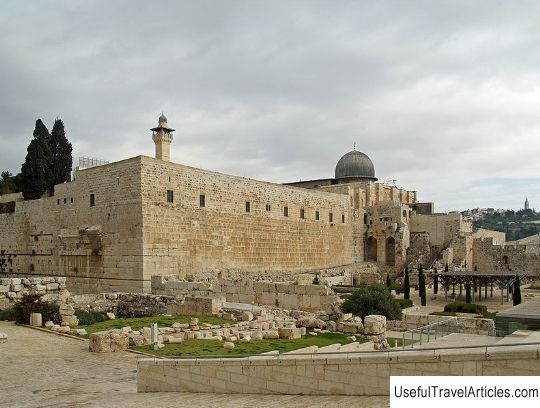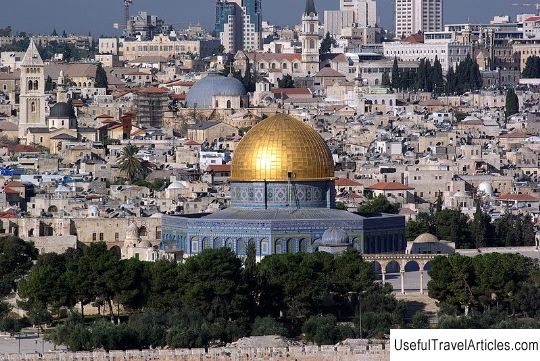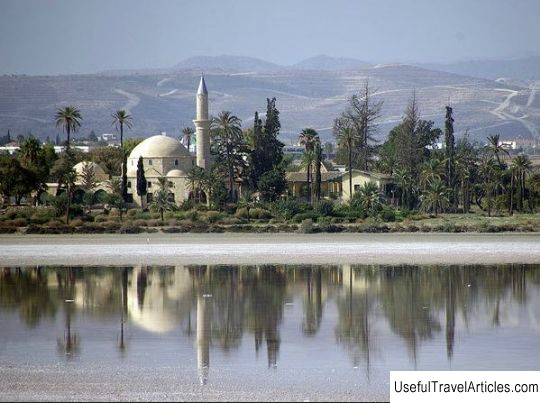Al-Aqsa Mosque description and photos - Israel: Jerusalem

Al-Aqsa Mosque description and photos - Israel: Jerusalem. Detailed information about the attraction. Description, photographs and a map showing the nearest significant objects. The title in English is Al-Aqsa Mosque. Photo and descriptionThe Al-Aqsa Mosque, on the Temple Mount in the Old City, is the third most important shrine in the Islamic world. Tradition says that the Prophet Muhammad ascended to heaven from here after his night journey from Mecca to Jerusalem. The Temple Mount is the holiest place in Judaism: it was here that the First Temple of Solomon stood (destroyed by the army of Nabuhudnezzar in 586 BC e.) and the Second Temple, destroyed by the Romans in 70. From it remained a powerful artificial platform, on which already in 705 under the Umayyads there was a small prayer house, a distant predecessor of the present mosque. The miraculous night journey of the Prophet Muhammad (Isra) took place almost a century earlier, about 621 year. According to the hadiths about the life of the prophet, at night the angel Jabrail appeared to him and offered to go to Jerusalem. The sentient animal Burak (sparkling, with a human face, "above a donkey and below a mule") in the blink of an eye delivered travelers to the gate of the temple. Here the prophet met with Ibrahim, Musa and Isa (Abraham, Moses and Jesus) and guided them in common prayer. After that, Muhammad ascended to the throne of Allah (performed miraj). Hadiths say: on the way, he saw hell and heaven, then received an instruction from Allah about five times daily prayer obligatory for Muslims, and then returned to Mecca. There is no evidence of what the temple looked like during the time of the Prophet Muhammad. However, it is known that the mosque built by the Umayyads was destroyed by an earthquake in 746. Caliph al-Mansur rebuilt it in 754, al-Mahdi rebuilt it in 780. But in 1033, a new earthquake destroyed most of al-Aqsa. During the renovation work, the mosque received important additions: a dome, a beautiful facade, minarets. In 1099, Jerusalem was captured by the crusaders; they housed a church, a palace, and a stable. The Templars, who set up their headquarters in the building, carried out major construction work. The mosque was restored after Saladin conquered the city for the Muslim world in 1187. In subsequent centuries, al-Aqsa was repaired and completed under the Ayyubids, Mamluks, and the Ottoman Empire. Nowadays, when the Old City is under Israeli control, the territory of the Temple Mount, together with the mosque, has been transferred to the Muslim waqf. This means that the Israeli state has transferred the land and the buildings on it for religious purposes and cannot take them back. The mosque is huge: 83 meters long, 56 meters wide. At the same time, it accommodates five thousand worshipers. Its large dome, originally resting on wooden structures, was replaced by a concrete one in 1969. The oldest of the four minarets, in the southwest corner, was erected in 1278 by order of the Mamluk Sultan Lachin. In the facade of the mosque, the heritage of the great Fatimid era and the Romanesque arches erected by the Crusaders are intricately mixed. The most noticeable part of the interior is 121 stained glass windows, left over from the Abbasid and Fatimid eras. The drum of the dome and the walls underneath are decorated with mosaics, the columns are made of white marble. in the southwestern corner, built in 1278 by order of the Mamluk sultan Lachin. In the facade of the mosque, the legacy of the great Fatimid era and the Romanesque arches erected by the Crusaders are bizarrely mixed. The most notable part of the interior is 121 stained glass windows, left over from the Abbasid and Fatimid eras. The drum of the dome and the walls underneath are decorated with mosaics, the columns are made of white marble. in the southwestern corner, built in 1278 by order of the Mamluk sultan Lachin. In the facade of the mosque, the legacy of the great Fatimid era and the Romanesque arches erected by the Crusaders are bizarrely mixed. The most notable part of the interior is 121 stained glass windows, left over from the Abbasid and Fatimid eras. The drum of the dome and the walls underneath are decorated with mosaics, the columns are made of white marble.     We also recommend reading Antiparos island description and photos - Greece: Paros island Topic: Al-Aqsa Mosque description and photos - Israel: Jerusalem. |




